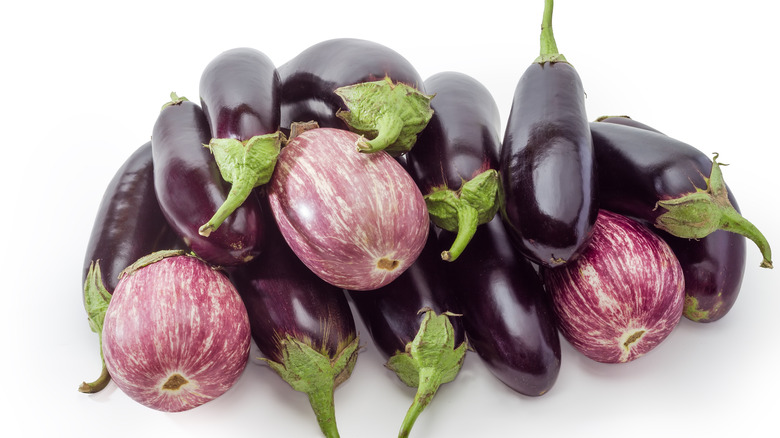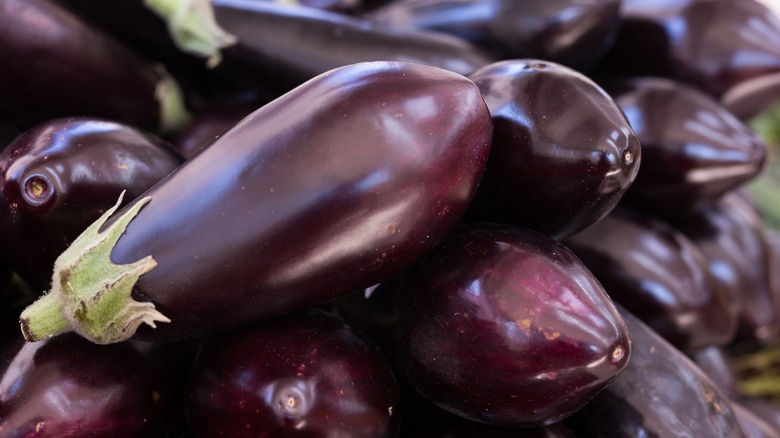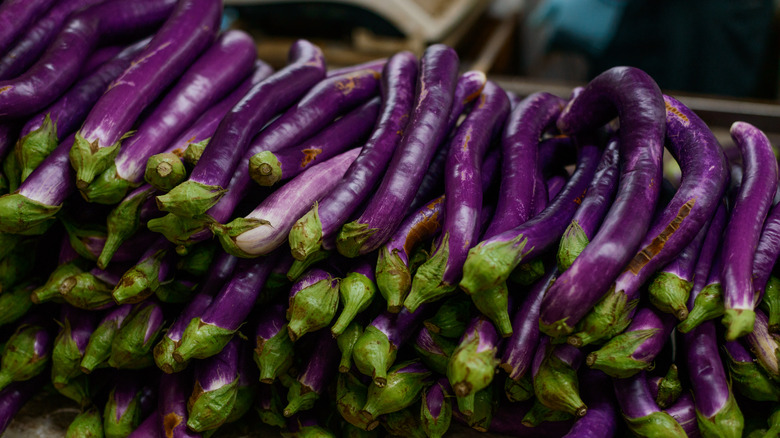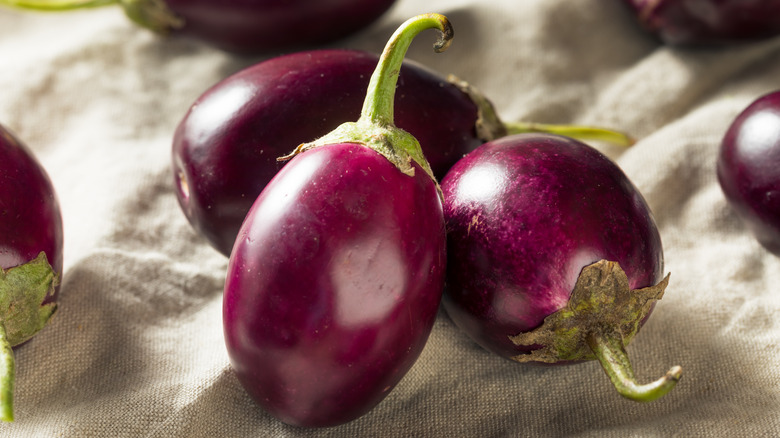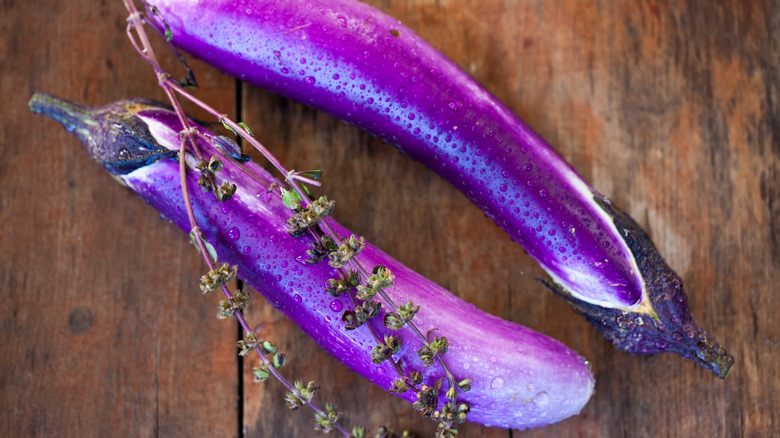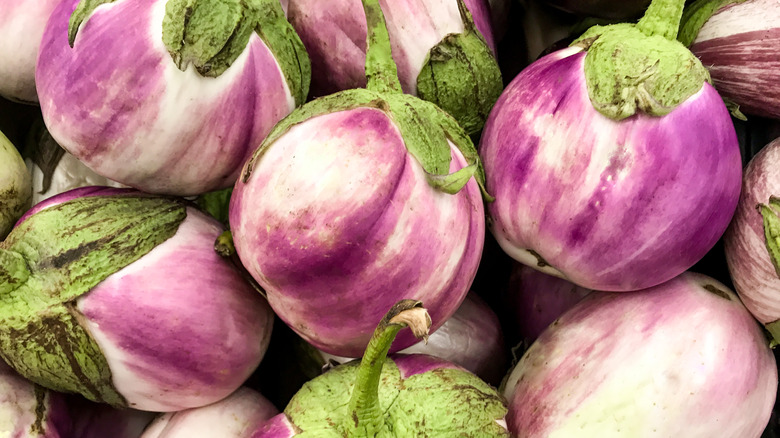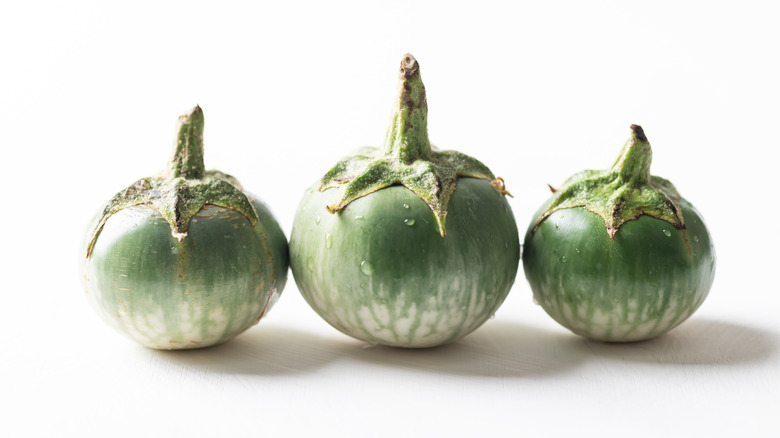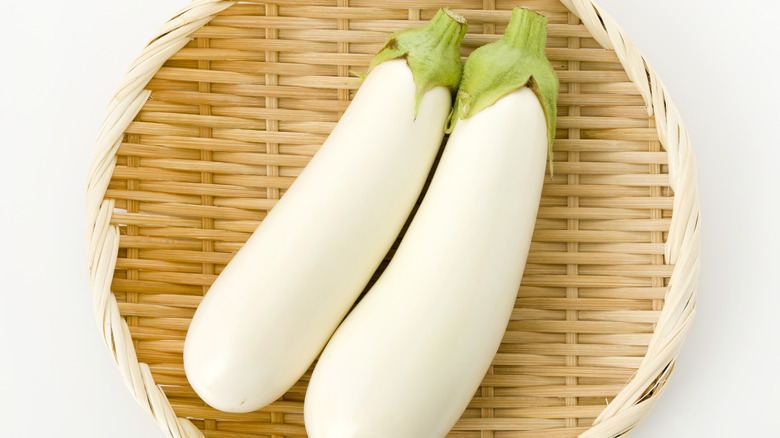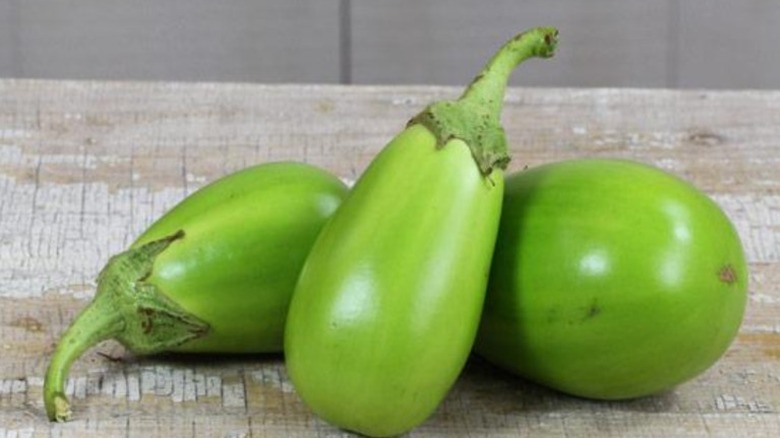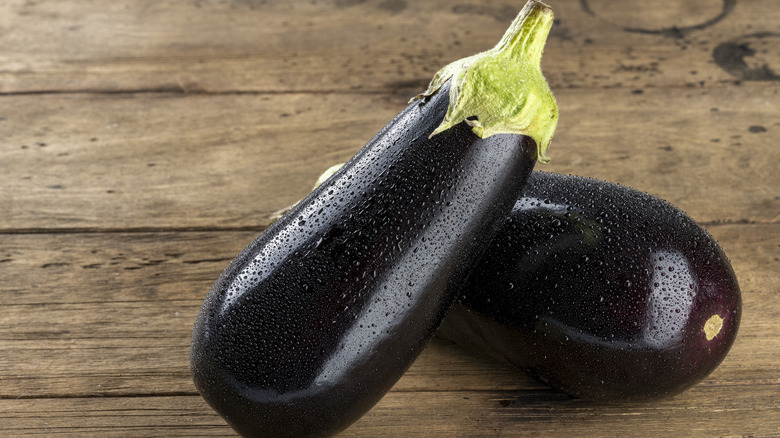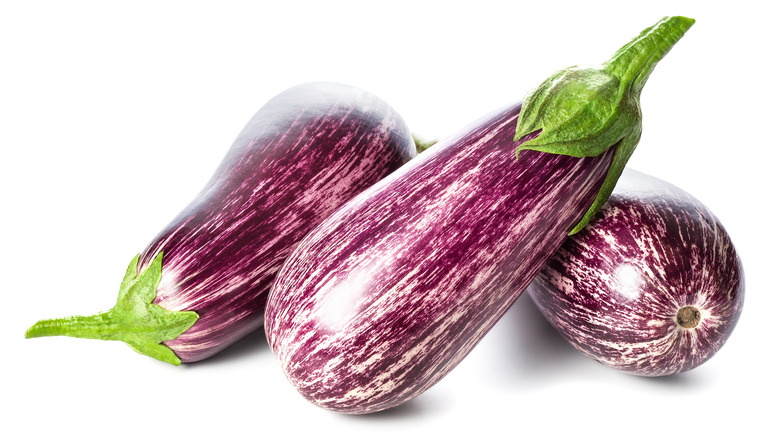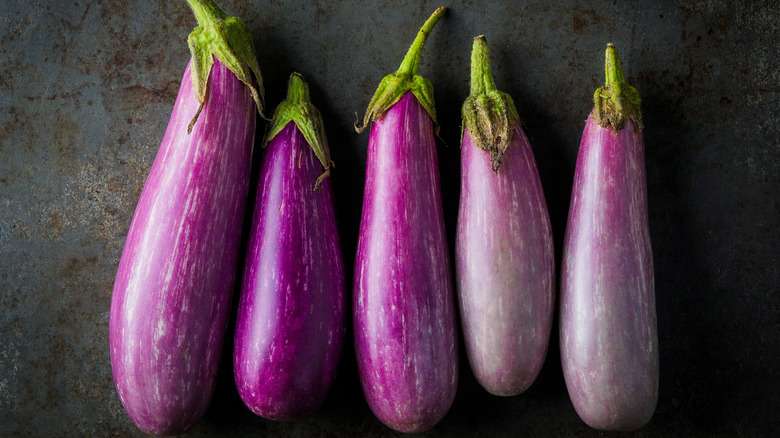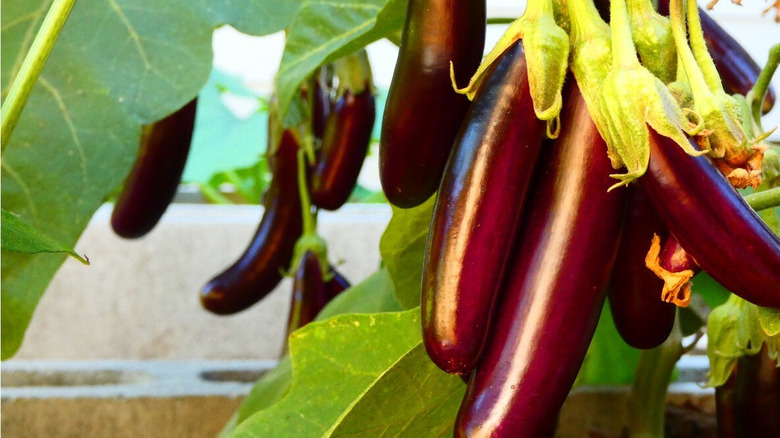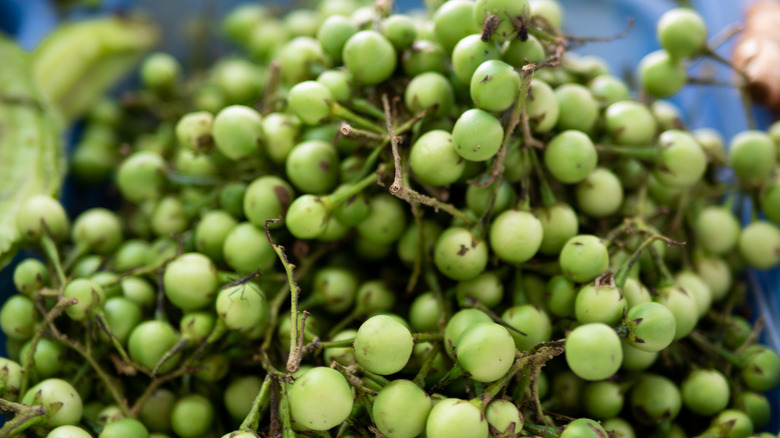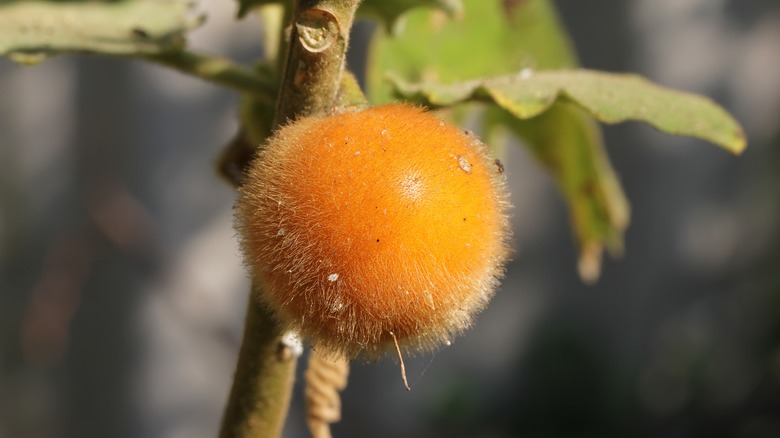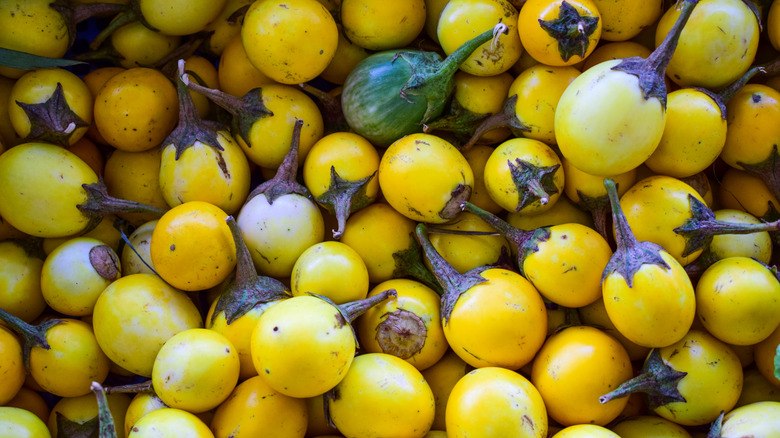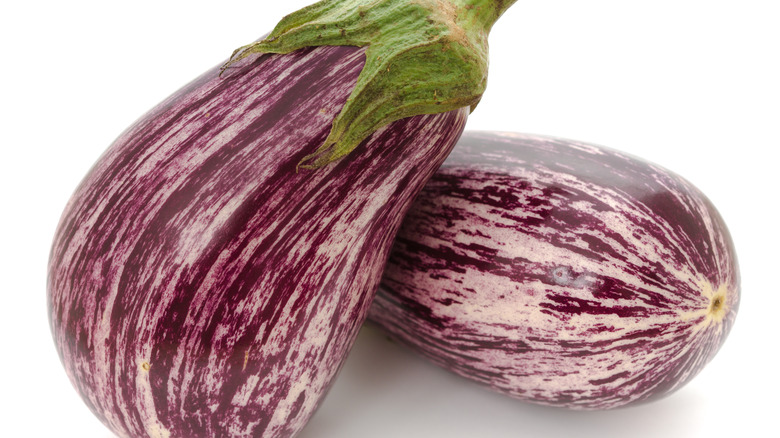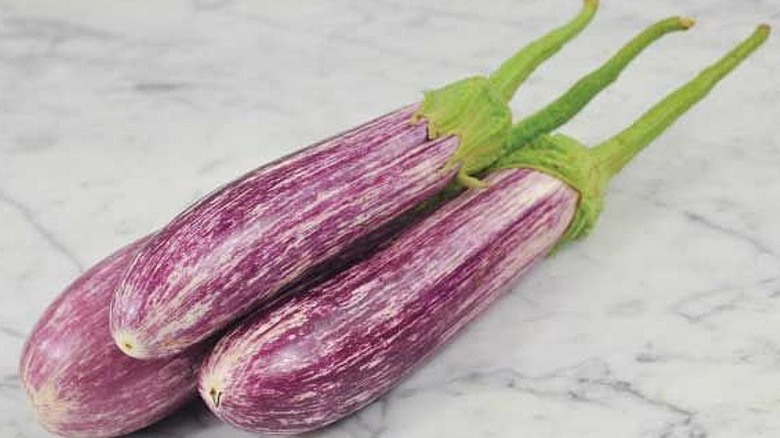A Beginner's Guide To The Wide World Of Eggplant Varieties
Whether you call them eggplant or aubergine, these uniquely shaped fruits are one of the most diverse members of the Nightshade family (Solanaceae), which has 3,000 species, including potatoes, peppers, and tomatoes. Eggplants originated in India and were first cultivated there and in Southeast Asia approximately 1,500 years ago. The earliest known reference to the eggplant in print comes from a fifth-century Chinese book which notes that women would dye their teeth with eggplant. The eggplant was brought to Europe via Arab traders, to Africa by Persian traders, and to the New World by the Spaniards. By the 1800s, they were grown in gardens throughout the U.S. They get their name from a variety found in Europe during the 1700s, which had a shape and color resembling an egg.
Eggplants are remarkably high in antioxidants, vitamins, and minerals. They can be vital in promoting heart health and controlling blood sugar, according to Healthline. Although several studies suggest a link between foods from the Nightshade family and inflammation due to the high levels of alkaloids found in these fruits, there is limited research to support this (via WebMD).
Eggplants are popular in cuisines across the globe for their distinct flavor and suitability in a wide range of recipes. They typically have a firm-fleshed texture that softens when cooked, seeds that can make them quite bitter if not fixed properly, and a flavor that can range from sweet to meaty depending upon the type. Read on for a breakdown of different eggplant varieties and ways to cook them.
American or Globe eggplant
The American or Globe eggplant is one of the most recognizable eggplants. If you go to the supermarket, this is likely the one variety of eggplant you will find. It has a dark purple hue, thick, glossy skin, and a prickly green stem. One of the largest eggplant species, these eggplants can range in size from 6 to 10 inches long and 2 to 4 inches in diameter on average. They should have a firm, whitish interior that is slightly spongy and contains some seeds along the length of the center. These eggplants are available year-round but are at their apex of flavor in the middle of the summer.
When shopping for this type of eggplant, select specimens that feel heavy for their size. These typically have fewer seeds in them, which will make them less bitter to eat. The meaty flesh of the American or Globe eggplant is ideal for recipes like eggplant parmesan and baba ghanoush. When working with these eggplants, we recommend leaving the peel intact, or they will disintegrate into your dish. We also recommend liberally salting and draining the eggplant on paper towels once sliced or cut to remove any excess moisture and inhibit the absorption of too much fat in the cooking process.
Chinese eggplant
The Chinese eggplant, also known as Pingtung Long, is an eggplant species characterized by its long, slender shape that can either be curved or straight and ranges in size from 6 to 8 inches in length and up to 2 inches in diameter. As its name suggests, this variety of eggplant is found in Chinese cuisine. It has firm skin, varying in color from lighter indigo to a deep plum. Its flesh is what gives this particular eggplant its utility and distinct flavor. It has a cotton hue and naturally lacks a lot of seeds. Because of its low seed content, this is a much creamier and less bitter eggplant than most of its cousins.
Due to its distinct size and flesh, this eggplant cooks rapidly, making it ideal in stir-fries, although it is also delicious baked, grilled, braised, and sautéed. When cooked, it develops a rich, meaty umami flavor that lends itself to the aggressive flavors typical of Chinese cuisine, including fish sauce, soy sauce, cumin, garlic, ginger, chili peppers, fermented bean paste, and mushrooms. The skin of this eggplant should never get peeled off, or it will not hold its shape when cooked. It is also where many of the beneficial nutrients associated with this eggplant are located, including the antioxidant anthocyanin.
Indian eggplant
Also known as Ratna or Brinjal, the Indian eggplant is one of the most common ingredients in Indian cuisine. This particular variety is petite, ranging in diameter from 2 to 3 inches. It often gets described as resembling the shape of a large egg, with deep purple skin that has a firm texture. Its interior is uniquely tender, yielding a creamy texture when cooked. While it has seeds, they are small and not particularly bitter, giving this eggplant a sweet flavor perfect for Indian curries. Its size and shape also make it ideal for stuffing with aromatics like garlic, ginger, and onions seasoned liberally with spices typical of Indian cuisines, such as cumin, turmeric, and coriander.
India is the second largest producer of eggplant globally, behind China. Eggplants have long been a part of both India's culinary legacy and Ayurvedic medicine. One of the most popular Indian eggplant dishes is bharta, a roasted dip similar to baba ghanoush. Historically, the eggplant would get buried in hot ashes and roasted before being peeled and combined with chilies and spices. This smoky dip is best when served with naan and a cool, refreshing cucumber raita.
Japanese eggplant
The eggplant migrated to Japan from China in roughly the eighth century. Long considered a symbol of good luck in Japanese culture, the Japanese have cultivated numerous varieties of eggplant ranging in size and shape, from the Millionaire to the Konasu and Mangan breeds. The general characteristics of Japanese eggplants include a long, thin body, which can be either bent or straight and has an average length of 8 to 10 inches. These eggplants are typically thin-skinned, making them extremely fragile. The skin can range from a lighter purple to almost black. Its cream-colored flesh is soft, virtually seedless, and highly absorbent, ideal for Japanese culinary techniques and flavors.
The Japanese eggplant must always be prepared without peeling the skin before being sautéed, grilled, stir-fried, broiled, or baked. Some popular Japanese eggplant recipes include pickled eggplant, nasu dengaku (grilled eggplant basted in a miso glaze), and the deep-fried delight nasu agebitashi. Because its flesh is so absorbent, we recommend using salty ingredients sparingly, or these eggplants can become easily overwhelmed. They shine best when juxtaposed with sweet and savory seasonings and distinct textures, including crunchy nuts.
Rosa Bianca eggplant
The Rosa Bianca eggplant is found in Italy, specifically the island of Sicily. It is one of the more unusual-looking eggplants, making it a popular choice among food enthusiasts. Its distinct shape resembles that of a small pumpkin, with a diameter of roughly 6 inches. Unlike other eggplant varieties, which typically have a solid-colored skin, this variety has striated skin, with hints of lavender alternating with white coating the fruit lengthwise. Its meat is soft and buttery when cooked, with very few seeds, giving it a mild flavor without a hint of bitterness.
This eggplant is ideal for stuffing thanks to its size and shape. Try using spicy Italian sausage combined with ricotta and parsley. Garnish with freshly grated Parmigiano Reggiano before baking it. The Rosa Bianca is also a beautiful eggplant for a ratatouille or other layered casserole loaded with colorful vegetables. As with other eggplants, it is recommended not to remove the skin before cooking, or its flesh will disintegrate.
Thai eggplant
Thai eggplants originated in India and are available in Asian markets across the globe. These eggplants are often known by other monikers, including Round eggplant, Makua pot, Petch Slam, Tiger Hybrid, Green Doll, and (our favorite) the Kermit hybrid. They are a small, round eggplant roughly the size of a golf ball, about 1 inch in diameter. Their skins tend to be firm, with colors ranging from lime green to dark green with white stripes. They are a very seedy variety of eggplant, giving their interior a somewhat crunchy texture and bitter flavor. Unlike other breeds of eggplant, this particular variety can be consumed raw, making it a popular snack in Thailand.
As with other eggplants, Thai eggplant can be cooked in numerous ways, although they are most popular cut in half and cooked into a curry seasoned with red curry paste, ginger, cilantro, coconut milk, and a splash of lime juice. This preparation helps soften the eggplant and tames the bitterness of its seeds. They can also be battered and fried in a tempura-like batter, highlighting their distinctive crunchy texture.
White eggplant
White eggplants fall into two categories, those that are strictly ornamental and those domesticated for culinary purposes. Several types of edible white eggplants exist, including Casper, Easter Egg, White Beauty, Cloud Nine, Ghostbuster, Albino, Tango, and Garden Eggs. While these domesticated breeds vary in size from 3 to 5 inches in length, they are generally smaller than their purple cousins. White eggplants tend to have slightly thicker skins with flesh that is somewhat milder in flavor and less bitter than purple eggplants. The meat is also less spongy and has a custardy texture when cooked, despite the large number of seeds they generally retain. You will most likely find white eggplant at local farmer's markets during the peak of summer.
White eggplants are used similarly to purple eggplants but are best in stir-fries, grilled, or stewed together with robust flavorings such as chilis, fresh herbs, ginger, garlic, miso paste, and strong cheeses. These angelic-hued fruits make a delightful variation on an eggplant parmesan thanks to their distinct flavor and color. While these eggplants now grow all across the globe, they have appeared in Indian and Chinese cuisine for hundreds of years, particularly in medicinal applications.
Little Green eggplant
While green eggplants of various sizes and shapes are available across the globe, the Little Green eggplant, known as Ao Daimaru, is a kyo yasai (Kyoto vegetable) that has become synonymous with Saitama Prefecture in Japan. In 1868, green eggplants proliferated throughout Japan, becoming an indelible part of Japanese culture. These eggplants are generally round and about 3 inches long, with shiny lime green-colored skin. Their interior flesh is firm yet porous, containing very few seeds. Little Green eggplant has a rich umami flavor and is far less bitter than other varieties.
Although they can be used similarly to other eggplants, particularly in stir-fries and curries, in Japanese cuisine, they most frequently get added to dashi, a soup made of kelp and dried bonito fish flakes, or pickled into a classic tsukemono along with miso and vinegar. They are also ideal as a meat substitute with tofu in any dish with aggressive flavors that the eggplant can absorb, such as curry leaves, soy, coconut milk, garam masala, and turmeric. Try frying them coated in a delicate tempura batter for a crispy treat.
Italian Nadia eggplant
The earliest indication of the cultivation of eggplant in Italy dates back to 1309 on the island of Sicily. Today, many different types of eggplant are grown in Italy, including Listada de Gandia, Rotonda Bianca di Imola, Cucuzzi, Prosperosa, Vittoria PS, Violette di Firenze, and Nadia. Nadia is a particularly delicate yet flavorful variety of eggplant with an oblong shape that can grow up to 6 inches long. Its skin is thin, smooth, and shiny, with a color that is such a deep purple it almost looks black.
Its flesh is soft and creamy, with varying levels of seeds, depending upon the size of the eggplant and whether it is male or female. Smaller male eggplants have fewer seeds and are less bitter. To determine the sex of the eggplant, look at the indent on the bottom of the fruit. A deep crevice that looks like a hyphen is female. A more shallow circular dent means it's male. This particular breed is also a prolific plant, yielding tons of fruit within one growing season, which can be cubed and frozen for future use. While the Nadia is perfect in classic Italian dishes, like eggplant parmesan, it is also ideal in stews, like a Moroccan tagine with tomatoes, chickpeas, preserved lemons, ras el hanout, and harissa paste. Garnish with Greek yogurt and toasted almonds for a delightful pop of both flavor and texture.
Graffiti or Zebra eggplant
Whether you call it a Graffiti or Zebra eggplant, this variety gets characterized by distinctive purple and white stripes reminiscent of either moniker. This eggplant is often associated with the Mediterranean but can be found at farmer's markets and gourmet grocers across the globe from mid-summer through early fall. These streaky, oval-shaped eggplants range from just under 3 inches to almost 6 inches long. Their skin is much thinner and more supple than their purple counterparts. The meat inside is tender, with a hint of fruitiness that gives it a distinctive sweet flavor despite the seeds it contains.
Graffiti or Zebra eggplants are excellent for grilling, roasting, baking, or sautéing. They also do not require advanced salting to eliminate bitterness or moisture content, making them slightly less of a hassle to prepare. Because of their size, these eggplants are perfect for stuffing. We'd recommend a lamb stuffed recipe seasoned with smoked paprika, cumin, and zaatar or a vegetarian stuffing made with quinoa, chickpeas, fresh herbs, preserved lemons and topped with feta or goat cheese.
Fairy Tale eggplant
As its name suggests, this particular eggplant is like something straight out of a fairy tale. Indeed, Hans Christian Andersen himself could not have invented a fruit as delicate and delectable. The Fairy Tale eggplant is distinct because of its small size, roughly 4 inches in length, with supple lavender skin speckled with white. Its meat is cream-colored, with a soft, buttery texture and virtually no seeds. Even the plant it grows on defies belief — it's a dwarf plant that stands about 24 inches tall and can be grown in a container, making it ideal for small gardens.
Chefs love this little gem because of how quickly it cooks. Cut one in half and pan-sear or grill the eggplant flesh side-down to char the meat, which will give it a nutty flavor while retaining a slightly meaty texture. And unlike other eggplants, you do not have to overcook the skin, which enables it to keep its colorful, spotty pattern. Serving the charred fruits garnished with cucumber raita, pomegranate seeds, and chopped macadamia nuts will have you revisiting the Fairy Tale eggplant in your dreams.
Little Finger eggplant
True to their moniker, these tiny eggplants generally get harvested when they are about the size of your little finger. They are a variety that hails from the Yamagata region of Japan, and their long, slender shape and dark purple skin are reminiscent of many Japanese eggplant species. What makes them distinct is how they grow. These plants are dwarf species, reaching 18 to 24 inches in height, which makes them ideal for growing in containers. The fruits themselves grow in clusters of five to 10 fruits per branch. They can get harvested when young or allowed to grow to larger sizes, which will not influence their flavor adversely, unlike other eggplants, which can get bitter if not harvested smaller due to the proliferation of seeds in larger fruit.
The flesh of these tiny eggplants is tender and creamy when cooked, with a sweeter flavor ideal for stir-fries, grilling, and even pickling whole. Due to their diminutive size, they cook rapidly and should not be overcooked, or their shape will become distorted. Try roasting these after marinating them in a combination of sesame oil, soy sauce, chili sauce, and brown sugar for a quick appetizer or snack.
Cluster eggplant
The Cluster eggplant is one of the more unique varieties, bearing little resemblance to other species of domesticated eggplant. They typically grow wild and have been semi-cultivated. In fact, in 1983, they joined the Federal Noxious Weed List in the U.S. They can be found in farmer's markets and specialty grocers worldwide, although they are indigenous to South America and Africa. Other names for this species include Pea eggplant, Bunch eggplant, Pea aubergine, Wild eggplant, and Turkey berry.
These eggplants typically range in size from that of a pea to a grape, growing in bunches of 10 to 15 fruits per cluster on shrubs that can reach 16 feet tall. Their color ranges from lime green to canary yellow, depending upon ripeness. They are spiny, hairy plants that can be challenging to handle. The fruits can have hundreds of tiny seeds, making them crunchy and bitter.
Cluster eggplants are ubiquitous in Thai cuisine, where they're prepared both cooked and raw. One of their most well-known applications is in a nam prik kapee, a Thai shrimp and chili paste. They are also common in Thai curries, pickles, and soups. To minimize the impact of their tart seeds, boil the berries slightly before use.
Hairy eggplant
Another unusual member of the eggplant family is the Hairy eggplant, also known as Coconilla, Bura-Bura, Bolo maka, Cocochat, Pupu, Tupido, Pimpla, and Tupirito. This native of Southeast Asia can be found in both its wild and domesticated forms. The wild fruit gets characterized by its distinctly furry skin, while its cultivated variations are often smooth. The fruit ranges from ½ to 1 inch in diameter and is a bright orange hue when ripe. The interior flesh has abundant edible yellow-orange seeds with a crisp texture and flavor invoking the tropics. This pulp is similar in flavor to the taste of passion fruit, slightly sweet and tangy.
Hairy eggplants have long featured heavily in the medicinal folk traditions of many Asian cultures. They are turned into poultices and tinctures to treat everything from sexually transmitted diseases to coughs to generalized pain. From a culinary perspective, the Hairy eggplant is best prepared, raw or cooked, once the hairs get removed from the exterior skin. The tart pulp gets squeezed into curries and sauces, particularly those featuring coconut milk. They are also commonly added for contrast in flavor to a Thai nam prik kapi shrimp and chili sauce.
Baby Yellow eggplant
Baby Yellow eggplants are an heirloom variety of eggplant hailing from Thailand. These eggplants grow in bunches on a bush. Their size ranges from 1 to 2 inches in diameter, with intense canary yellow skin. Their interior has tons of acerbic brown seeds, which should be removed before cooking. This breed of eggplant is atypically tart, having a thick flesh that can best get enjoyed when cooked after being soaked in water for an extended period to reduce its overbearing bitterness. Other names for this type of eggplant include Thai Round Yellow, Thai Yellow Egg, and Golden Eggs.
The Baby Yellow eggplant is integral to Thai culture, commonly used to treat stomach ulcers and featured prominently in a "Cinderella"-like folk story. They are best in recipes with strong flavors that can tame their inherent sour flavor, like coconut milk curries with lemongrass, chilis, garlic, lime, coriander, and Thai basil. They may be a bit of an acquired taste and texture for Western palates.
Nubia eggplant
The Nubia is yet another variegated, or striped, eggplant heralding from Italy. Its size ranges from 4 to 8 inches in length and up to 4 inches in diameter. Its stripes alternate from a deep maroon color to pink or white speckles. The Nubia is a late-harvest variety of eggplant, making it heartier. Its skin tends to be quite dense, and its flesh is similar to other Italian eggplants: cream-colored with a spongy texture and semi-sweet flavor.
While this species of eggplant can get used much the same way as other larger eggplant breeds, it is best roasted, grilled, or in caponata. Caponata is a Sicilian dish that is found across Italy. Like a French ratatouille, caponata takes advantage of the bounty of summer, stewing chopped eggplant together with tomatoes, olives, capers, onions, and basil to create a kind of chutney that is perfect as a topping for bruschetta. To aid in tenderizing this particular eggplant, we recommend salting the cut meat liberally and allowing it to sit for approximately 30 minutes before cooking it.
Antigua eggplant
Yet another in the vast canon of Italian heirloom eggplant varieties, the Antigua eggplant is a medium-sized eggplant that can be 6 to 8 inches long and 3 inches in diameter. It has an oblong shape with striped skin alternating in streaks of white and lilac along the length of the fruit. The Antigua is a distinctly sweet-fleshed eggplant with a mellow, buttery flesh that is never bitter, even at larger sizes.
This breed of eggplant can get used in virtually any recipe, but it shines when it is the star, without too many other intense or complicated ingredients. It would be ideal in a risotto or with pasta mixed with just a hint of ricotta, fresh mint, and pine nuts. You could also use it as a stuffing eggplant which serves two people. After removing the flesh of the eggplant, sauté lightly in some extra-virgin olive oil, garlic, red pepper, fresh tomatoes, and onions. Top with freshly grated Pecorino Romano cheese before baking.
